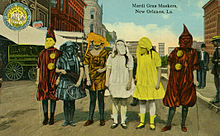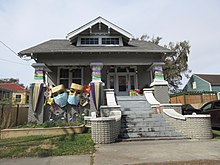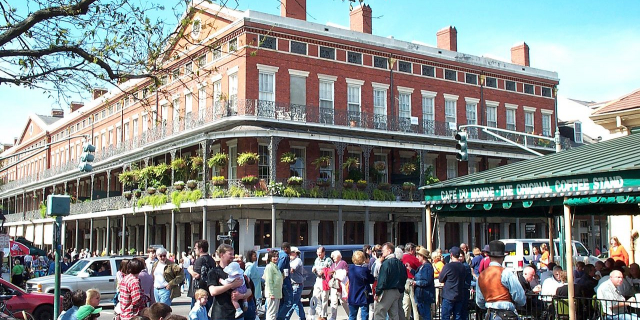The holiday of Mardi Gras is celebrated in southern Louisiana, including the city of New Orleans. Celebrations are concentrated for about two weeks before and through Shrove Tuesday, the day before Ash Wednesday (the start of lent in the Western Christian tradition). Mardi Gras is French for Fat Tuesday, the season is known as Carnival and begins on 12th Night, January 6th, and extends until midnight before Ash Wednesday. Club, or Krewe, balls start soon after, though most are extremely private, with their Kings and Queens coming from wealthy old families and their courts consisting of the season's debutantes. Most of the high society Krewes do not stage parades. As Fat Tuesday gets nearer, the parades start in earnest. Usually there is one major parade each day (weather permitting); many days have several large parades. The largest and most elaborate parades take place the last five days of the Mardi Gras season. In the final week, many events occu...Read more
The holiday of Mardi Gras is celebrated in southern Louisiana, including the city of New Orleans. Celebrations are concentrated for about two weeks before and through Shrove Tuesday, the day before Ash Wednesday (the start of lent in the Western Christian tradition). Mardi Gras is French for Fat Tuesday, the season is known as Carnival and begins on 12th Night, January 6th, and extends until midnight before Ash Wednesday. Club, or Krewe, balls start soon after, though most are extremely private, with their Kings and Queens coming from wealthy old families and their courts consisting of the season's debutantes. Most of the high society Krewes do not stage parades. As Fat Tuesday gets nearer, the parades start in earnest. Usually there is one major parade each day (weather permitting); many days have several large parades. The largest and most elaborate parades take place the last five days of the Mardi Gras season. In the final week, many events occur throughout New Orleans and surrounding communities, including parades and balls (some of them masquerade balls).
The parades in New Orleans are organized by social clubs known as krewes; most follow the same parade schedule and route each year. The earliest-established krewes were the Mistick Krewe of Comus, the earliest, Rex, the Knights of Momus and the Krewe of Proteus. Several modern "super krewes" are well known for holding large parades and events (often featuring celebrity guests), such as the Krewe of Endymion, the Krewe of Bacchus, as well as the Zulu Social Aid & Pleasure Club—a predominantly African American krewe. Float riders traditionally toss throws into the crowds. The most common throws are strings of colorful plastic beads, doubloons, decorated plastic "throw cups", and small inexpensive toys. Major krewes follow the same parade schedule and route each year.
While many tourists center their Carnival season activities on Bourbon Street, major parades originate in the Uptown and Mid-City districts and follow a route along St. Charles Avenue and Canal Street, on the upriver side of the French Quarter. Walking parades - most notably the Krewe du Vieux and 'tit Rex - also take place downtown in the Faubourg Marigny and French Quarter in the weekends preceding Mardi Gras Day. Mardi Gras Day traditionally concludes with the "Meeting of the Courts" between Rex and Comus.
The first record of Mardi Gras being celebrated in Louisiana was at the mouth of the Mississippi River in what is now lower Plaquemines Parish, Louisiana, on March 2, 1699. Iberville, Bienville, and their men celebrated it as part of an observance of Catholic practice. The date of the first celebration of the festivities in New Orleans is unknown. A 1730 account by Marc-Antoine Caillot celebrating with music and dance, masking and costuming (including cross-dressing).[1] An account from 1743 that the custom of Carnival balls was already established. Processions and wearing of masks in the streets on Mardi Gras took place. They were sometimes prohibited by law, and were quickly renewed whenever such restrictions were lifted or enforcement waned.
In 1833, Bernard Xavier de Marigny de Mandeville, a rich plantation owner of French descent raised money to fund an official Mardi Gras celebration. James R. Creecy in his book Scenes in the South, and Other Miscellaneous Pieces describes New Orleans Mardi Gras in 1835:[2]
 The Carnival at New Orleans, 1885
The Carnival at New Orleans, 1885Shrove Tuesday is a day to be remembered by strangers in New Orleans, for that is the day for fun, frolic, and comic masquerading. All of the mischief of the city is alive and wide awake in active operation. Men and boys, women and girls, bond and free, white and black, yellow and brown, exert themselves to invent and appear in grotesque, quizzical, diabolic, horrible, strange masks, and disguises. Human bodies are seen with heads of beasts and birds, beasts and birds with human heads; demi-beasts, demi-fishes, snakes' heads and bodies with arms of apes; man-bats from the moon; mermaids; satyrs, beggars, monks, and robbers parade and march on foot, on horseback, in wagons, carts, coaches, cars, &c., in rich confusion, up and down the streets, wildly shouting, singing, laughing, drumming, fiddling, fifeing, and all throwing flour broadcast as they wend their reckless way.
In 1856, 21 businessmen gathered at a club room in the French Quarter to organize a secret society to observe Mardi Gras with a formal parade. They founded New Orleans' first and oldest krewe, the Mistick Krewe of Comus. According to one historian, "Comus was aggressively English in its celebration of what New Orleans had always considered a French festival. It is hard to think of a clearer assertion than this parade that the lead in the holiday had passed from French-speakers to Anglo-Americans. ... To a certain extent, Americans 'Americanized' New Orleans and its Creoles. To a certain extent, New Orleans 'creolized' the Americans. Thus the wonder of Anglo-Americans boasting of how their business prowess helped them construct a more elaborate version than was traditional. The lead in organized Carnival passed from Creole to American just as political and economic power did over the course of the nineteenth century. The spectacle of Creole-American Carnival, with Americans using Carnival forms to compete with Creoles in the ballrooms and on the streets, represents the creation of a New Orleans culture neither entirely Creole nor entirely American."[3]
In 1875, Louisiana declared Mardi Gras a legal state holiday.[4] War, economic, political, and weather conditions sometimes led to cancellation of some or all major parades, especially during the American Civil War, World War I and World War II, but the city has always celebrated Carnival.[4]
The 1898, Rex parade, with the theme of "Harvest Queens," was filmed by the American Mutoscope Co.[5][6] The rumored but long-lost recording was rediscovered in 2022. The two-minute film records 6 parade floats, including one transporting a live ox. In December 2022, the film was deemed "culturally, historically, or aesthetically significant" by the National Film Registry by the Library of Congress.[7]
20th and 21st centuries Mardi Gras maskers; c. 1915 postcard
Mardi Gras maskers; c. 1915 postcardIn 1979, the New Orleans police department went on strike. The official parades were canceled or moved to surrounding communities, such as Jefferson Parish, Louisiana. Significantly fewer tourists than usual came to the city. Masking, costuming, and celebrations continued anyway, with National Guard troops maintaining order. Guardsmen prevented crimes against persons or property but made no attempt to enforce laws regulating morality or drug use; for these reasons, some in the French Quarter bohemian community recall 1979 as the city's best Mardi Gras ever.
In 1991, the New Orleans City Council passed an ordinance that required social organizations, including Mardi Gras Krewes, to certify publicly that they did not discriminate on the basis of race, religion, gender or sexual orientation, to obtain parade permits and other public licenses.[8] Shortly after the law was passed, the city demanded that these krewes provide them with membership lists, contrary to the long-standing traditions of secrecy and the distinctly private nature of these groups. In protest—and because the city claimed the parade gave it jurisdiction to demand otherwise-private membership lists—the 19th-century krewes Comus and Momus stopped parading.[9] Proteus did parade in the 1992 Carnival season but also suspended its parade for a time, returning to the parade schedule in 2000.
Several organizations brought suit against the city, challenging the law as unconstitutional. Two federal courts later declared that the ordinance was an unconstitutional infringement on First Amendment rights of free association, and an unwarranted intrusion on the privacy of the groups subject to the ordinance.[10] The US Supreme Court refused to hear the city's appeal from this decision.
Today, New Orleans krewes operate under a business structure; membership is open to anyone who pays dues, and any member can have a place on a parade float.
Effects of Hurricane KatrinaThe devastation caused by Hurricane Katrina on August 29, 2005, caused a few people to question the future of the city's Mardi Gras celebrations. Mayor Nagin, who was up for reelection in early 2006, tried to play this sentiment for electoral advantage[citation needed]. However, the economics of Carnival were, and are, too important to the city's revival.
The city government, essentially bankrupt after Hurricane Katrina, pushed for a scaled back celebration to limit strains on city services. However, many krewes insisted that they wanted to and would be ready to parade, so negotiations between krewe leaders and city officials resulted in a compromise schedule. It was scaled back but less severely than originally suggested.
 2006: A Knights of Chaos float satirizes the U.S. Army Corps of Engineers, responsible for the failed levees in New Orleans
2006: A Knights of Chaos float satirizes the U.S. Army Corps of Engineers, responsible for the failed levees in New OrleansThe 2006 New Orleans Carnival schedule included the Krewe du Vieux on its traditional route through Marigny and the French Quarter on February 11, the Saturday two weekends before Mardi Gras. There were several parades on Saturday, February 18, and Sunday the 19th a week before Mardi Gras. Parades followed daily from Thursday night through Mardi Gras. Other than Krewe du Vieux and two Westbank parades going through Algiers, all New Orleans parades were restricted to the Saint Charles Avenue Uptown to Canal Street route, a section of the city which escaped significant flooding. Some krewes unsuccessfully pushed to parade on their traditional Mid-City route, despite the severe flood damage suffered by that neighborhood.
The city restricted how long parades could be on the street and how late at night they could end. National Guard troops assisted with crowd control for the first time since 1979. Louisiana State troopers also assisted, as they have many times in the past. Many floats had been partially submerged in floodwaters for weeks. While some krewes repaired and removed all traces of these effects, others incorporated flood lines and other damage into the designs of the floats.
Most of the locals who worked on the floats and rode on them were significantly affected by the storm's aftermath. Many had lost most or all of their possessions, but enthusiasm for Carnival was even more intense as an affirmation of life. The themes of many costumes and floats had more barbed satire than usual, with commentary on the trials and tribulations of living in the devastated city. References included MREs, Katrina refrigerators and FEMA trailers, along with much mocking of the Federal Emergency Management Agency (FEMA) and local and national politicians.
By the 2009 season, the Endymion parade had returned to the Mid-City route, and other Krewes expanding their parades Uptown.
2020 tandem float incidentsIn 2020, two parade attendees—one during the Nyx parade, and one during the Endymion parade, were killed after being struck and run over in between interconnected "tandem floats" towed by a single vehicle. Following the incident during the Nyx parade, there were calls for New Orleans officials to address safety issues with these floats (including outright bans, or requiring the gaps to be filled in using a barrier). Following the second death during the Endymion parade on February 22, 2020 (which caused the parade to be halted and cancelled), city officials announced that tandem floats would be banned effective immediately, with vehicles restricted to one, single float only.[11][12][13]
Impact of the COVID-19 pandemicUnknown to the participants and local leaders at the time, the 2020 Carnival season (with parades running from January through Mardi Gras Day on February 25) coincided with increasing spread of coronavirus disease 2019 (COVID-19) in the United States as part of a global epidemic.[14] At the time, scrutiny over large public gatherings had yet to emerge, while scrutiny over international travel primarily placed an emphasis on restricting travel from China—the country from which the disease originated.[15][14] The first case of COVID-19 in Louisiana was reported on March 9, two weeks after the end of Mardi Gras.[16]
Subsequently, the state of Louisiana saw a significant impact from the pandemic, with New Orleans in particular seeing a high rate of cases. Louisiana State University (LSU) associate professor Susanne Straif-Bourgeoi suggested that the rapid spread may have been aided by Mardi Gras festivities.[17][18] Researchers of the University of Louisiana at Lafayette determined that Louisiana had the fastest growth rate of cases (67.8%, overtaking New York's 66.1% growth) in the 14 days since its first reported case than any region in the entire world.[19][17]
Mayor LaToya Cantrell stated that she would have cancelled Mardi Gras festivities had she been provided with sufficient warning by the federal government, and criticized the Trump administration for downplaying the threat.[14][20] Amid continued spread of COVID-19 across the country, in early-November 2020 Cantrell stated that celebrations in 2021 would have to be "something different", as Mardi Gras could not be canceled outright since it is a religious observance. A sub-committee of the Mardi Gras Advisory Committee focused on COVID-19 proposed that parades still be held but with strict safety protocols and recommendations, including enforcement of social distancing, highly recommending the wearing of face masks by attendees, discouraging "high value" throws in order to discourage crowding, as well as discouraging the consumption of alcohol, and encouraging more media coverage of parades to allow at-home viewing.[21]
 As parades and large gatherings were canceled for the 2021 Mardi Gras season in New Orleans, some locals spent extra effort to decorate their homes and front yards for the holiday. Some nicknamed this "Yardi Gras".[22]
As parades and large gatherings were canceled for the 2021 Mardi Gras season in New Orleans, some locals spent extra effort to decorate their homes and front yards for the holiday. Some nicknamed this "Yardi Gras".[22]On November 17, 2020, Mayor Cantrell's communications director Beau Tidwell announced that the city would prohibit parades during Carnival season in 2021. Tidwell once again stressed that Mardi Gras was not "cancelled", but that it would have to be conducted safely, and that allowing parades was not "responsible" as they can be superspreading events.[23][24] This marked the first large-scale cancellation of Mardi Gras parades since the 1979 police strike.[25][26] Other krewes subsequently announced that they would cancel their in-person balls, including Endymion and Rex (who therefore did not name a King and Queen of Mardi Gras for the first time since World War II).[27][25][26]
On February 5, 2021, in response to continued concerns surrounding "recent large crowds in the Quarter" and variants of SARS-CoV-2 as Shrove Tuesday neared, Mayor Cantrell ordered all bars in New Orleans (including those with temporary permits to operate as restaurants) to close from February 12 through February 16 (Mardi Gras), and prohibited to-go drink sales by restaurants, and all packaged liquor sales in the French Quarter. To discourage gatherings, pedestrian access to Bourbon Street, Decatur Street, Frenchmen Street between 7:00 p.m. and 3:00 a.m., and Claiborne Avenue under the bridge, was restricted by checkpoints to those accessing businesses and homes within the areas. Mayor Cantrell stated that she would "rather be accused of doing too much than doing too little." The move caught some establishments off-guard, as they had been preparing for and anticipating business on Mardi Gras.[28][29]
Parades were allowed to return for 2022.[30] In December 2021, the city announced that parades would have modified routes in 2022 due to New Orleans Police Department staffing shortages.[31][32] On January 6, 2022, Mayor Cantrell stated during a kickoff event that "without a doubt, we will have Mardi Gras in 2022", citing high COVID-19 vaccination rates, and customarily asked residents to "do everything that we know is necessary to keep our people safe." The Krewe de Jeanne D'Arc ceremonially led their parade with a group of marchers in plague doctor outfits and brooms, tasked to "sweep the plague away".[30]
The city announced COVID-19 protocols for Mardi Gras 2022 in February 2022, which requires, at a minimum, all participants in a parade (including marchers, performers, and those a riding a float) to present proof of vaccination or a negative COVID-19 test from within the past 72 hours. Some krewes chose to not accept negative tests at all, while some krewes (such as the Krewe of Muses, which also announced plans to have COVID-19 rapid tests as throws)[33] had already announced vaccination requirements for parade participants ahead of the official requirement. Despite the presence of Omicron variant, city health director Jennifer Avegno stated that she was confident Mardi Gras could be conducted in a more normal fashion over 2021.[34][35][36]




































Add new comment